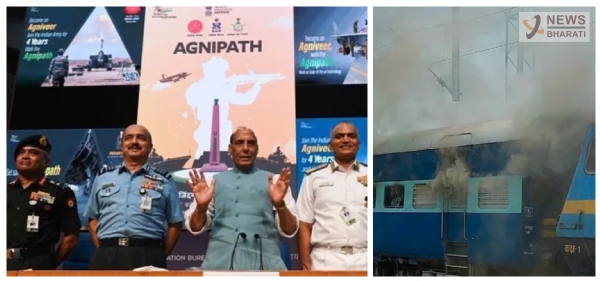Agnipath: The BJP is reaping what they sowed
Modi government"s decisions and indecisiveness in many instances is a big reason why these protests have taken place and the shape and form which these protests have acquired.
Total Views |
On 14th June 2022, the Modi government brought military recruitment reform named as Agnipath scheme. The reform was welcomed by the military veterans and defence experts. But within a few hours protests against this reform erupted across the country. Modi government's decisions and indecisiveness in many instances are one of the main reasons why these protests have taken place and the shape and form which these protests have acquired.

Right since the end of 2014 itself, the Modi government brought land reforms in the shape of the land ordinance. Within a year, the government backed down and rolled back those much-needed reforms. Many assume that it was a combination of a silly mistake and one clever comment/criticism by the opposition. When PM Modi met President Obama in Delhi, he was wearing that famous or infamous suit with his name written on it. Then Congress President Rahul Gandhi coined the phrase “Suit-Boot ki sarkar.” This one phrase and its implications forced the government to roll back reforms. This set a precedent that the mighty Modi Government with the full majority can be forced to take back decisions.
After winning the second term, the Modi government brought a flurry of reforms, abrogation of article 370, CAA, Farm laws, Labor codes, etc. Out of which only the first, Article 370 has been implemented. CAA has not been rolled back (yet) but it hasn't even been implemented yet. Farm laws and labor codes as most of us know have been rolled back. After all these reforms, there were huge protests from a section or some sections of society. Article 370, the Modi government did not budge, as it was a long-term commitment as well as an ideological issue. During CAA, it is safe to presume, that almost none of the protestors were BJP supporters or voters. Hence there is no rollback (yet). But even there, there was no strict police action against the Shaheen Bagh protestors, no strict action or conviction against any of the CAA rioters in Delhi. And to make it worse, it is still not implemented. But these are still ideological issues.
Also Read: Why attacking Ira Khan is utterly idiotic?
Then there are farm laws, which are not ideological for the BJP, as the BJP has no economic ideology. But the laws were well received by the agriculture experts as well as a huge majority of farmers in India, of course with the exception of Punjab, Haryana, and Western UP. But since the protestors this time around were either the core BJP voters of Western UP in the recent elections (especially since 2014) or sizeable BJP voters in Haryana or possible BJP voters in Punjab, i.e., Jat, the government backed down after a while, under the garb of “Desh ke liye wapas le raha hun”. This decision showed that if you show persistent street power, if you have substantial nuisance value, and if you have a few well articulate known faces supporting you nationally and internationally, the Modi government will bend. This again created a ‘tool kit’ for the opponents of the BJP. Lastly, the recent suspension of the ex-BJP spokesperson, showed that the government will not just bend but will bend over backward under international pressure. All these chickens have now come home to roost.
The same protestors who are opposing this Agnipath scheme, are very likely to be BJP supporters and voters. Some of them are openly saying that the government rolled back farm laws after ‘protests’, hence we will also ‘protest’ and force the government to take back this scheme. That is the confidence among general population about the Modi government’s capacity to take a U-turn on many much-needed, much fought for, and vigorously defended reforms. The BJP government has done this to itself over the last 8 years and the image of this government has gone from a decisive and strong government to an indecisive and weak government. All because of the series of inaction in the past.
Another reason why the government is bringing these reforms is to balance its defence budget. The Modi government implemented OROP in 2015. A long-term demand by the Army. The BJP had promised in their manifesto that they will fulfill this demand and provide OROP. The problem is that this government took itself too seriously and actually did it. Even at that time, the finance and defense minister at the time and veteran BJP leader Arun Jaitley had opposed it, although not publicly and not in so many words. He said, "I have my own formula on what OROP means. Somebody else may have their own formula on OROP but it has to be within reasonable and rational criteria. You can't have an OROP where pensions are revised every month or every year."
Also Read: The Muslim area trap
Now since its implementation, the pension of past pensioners was re-fixed on the basis of the pension of retirees for the calendar year 2013 and the benefit was effective July 2014. The pension was determined on the basis of the average of minimum and maximum pension of personnel retired in 2013 in the same rank and with the same length of service. The scheme envisages revision of pension once every five years. The yearly recurring expenditure on account of OROP is about Rs 7,123 crore. For about six years starting from July 2014, the total expenditure was over Rs 42,740 crore. For years, the pension bill has been responsible for the revenue component of the Ministry of Defence being larger than the capital outlay for modernization of the armed forces. And this is despite the total defence budget as a part of the Union Budget presented this year standing at Rs. 5.25 lakh crore — almost 10 percent more than last year’s allocation of Rs 4.78 lakh crore. A look at the Budget would tell us that the total revenue component allocated this year is Rs 3.65 lakh crore. Of this, pension pay-outs alone account for nearly Rs 1.20 lakh crore. Or Rs 1,19,696 crore to be precise. This allocation in revised estimates for pension in 2021-22 was Rs 1.17 lakh crore, making this year’s allocation a 2.5 percent increase over the revised estimates of last year. While that was the revised estimates for 2021-22, the actual pension Bill was even higher in the previous year of 2020-21 — Rs 1.28 lakh crore. This makes the defence pension account for nearly 25 percent of the total defence budget.
Such proportions of military budget going to pensions and salaries is not sustainable. Which is one of the reasons why the government is bringing in this scheme to maintain the fighting force without having to pay them pensions after retirement, in order to bring down the pension proportion of the budget and shift it to weapons procurement and modernization. These mistakes are now hounding the government and to an extent the nation at large.
Also Read: Why Urbanization is a necessity in India
PS: This is not to say that the Agnipath scheme is bad. It is undoubtedly good. But the implementation, just like Note Ban or even Article 370, is bad. And the communication is worse, just like during Farm laws protests.


